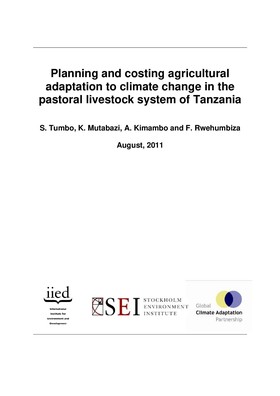Planning and costing agricultural adaptation to climate change in the pastoral livestock system of Tanzania

This study therefore tries to address costing and planning of adaptation to climate change in animal agriculture in Tanzania. The study adopted a bottom-up costing of adaptation actions that were identified using a case study approach.
The case study findings showed that a changing climate has resulted in environmental shocks and extreme events such as drought, excessive rains, floods and high temperatures, which have an caused inadequate supply of water and pasture, increases in disease incidences, and death of animals. It is probable that in the future such events are likely to have even more serious repercussions and therefore there is a compelling need to plan mitigation measures.
Through this study, various adaptation actions envisioned to be capable of fostering resilience have been identified and categorised as addressing three levels: development deficit, climate variability, or climate change-related extremes and shocks. Current annual adaptation costs were estimated at 226.7 M US$ and up to 3,987.5 M US$ by 2030; some of these costs are already being incurred by farmers (such as those involving temporary and permanent migration). From this study, some policy-relevant recommendations have been formulated:
1. The need to establish an environmental section in the Ministry of Livestock and Fisheries Development (MLFD).
2. The necessity for increased investment systems and structures for animal agriculture.
3. The need for increased investment in research, extension and training.
4. The requirement for more bottom-up studies on the economics of climate change in agriculture to be undertaken in order to fill knowledge gaps, apply existing and emerging methods, and improve the estimates.
Cite this publication
Available at https://www.iied.org/g03172